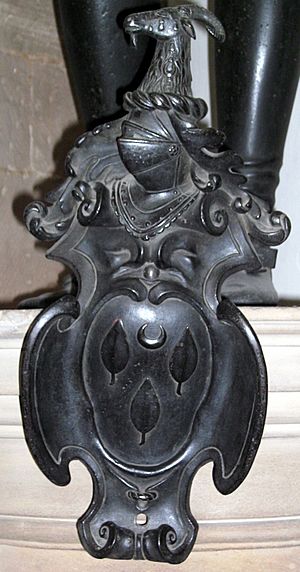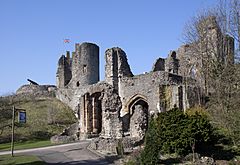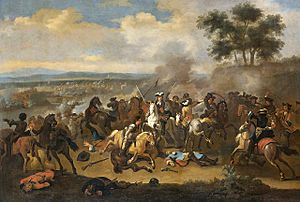Richard Leveson (died 1699) facts for kids
Quick facts for kids
Richard Leveson
|
|
|---|---|

Leveson coat of arms, on memorial in St Peter's Collegiate Church
|
|
| Member of Parliament for Newport, Isle of Wight |
|
| In office December 1692 – October 1695 |
|
| Governor of Berwick-upon-Tweed | |
| In office 1691–1699 |
|
| Member of Parliament for Lichfield |
|
| In office May 1685 – July 1687 |
|
| Personal details | |
| Born | 12 July 1659 Wolverhampton, Staffordshire |
| Died | 24 March 1699 (aged 39) |
| Nationality | English |
| Children | Two illegitimate sons |
| Military service | |
| Rank | Brigadier-General |
| Battles/wars | |
Richard Leveson was an English soldier and politician. He was born on 12 July 1659 in Wolverhampton, Staffordshire, and passed away in March 1699. Richard came from a wealthy family and served in the army. He was a Member of Parliament (MP) for Lichfield and later for Newport. He also held the important job of Governor of Berwick-upon-Tweed.
Richard Leveson started his military career serving King James II. However, during the Glorious Revolution in 1688, he switched his support to William III. He fought in major wars in Ireland and Flanders, showing his skills as a military leader. By the end of his life, he had reached the rank of Brigadier-General.
Contents
Who Was Richard Leveson?
Richard Leveson was the oldest of three sons. His parents were Sarah (who passed away in 1707) and Robert Leveson (who passed away in 1709). His father, Robert, was a rich merchant from Wolverhampton. Richard never married, but he had two sons. In his will, he made sure his sons and his two brothers were looked after.
His family had other important members too. For example, Sir Richard Leveson (1598-1661) was a relative. He was also connected to the powerful Leveson-Gower family.
Richard Leveson's Early Career
Richard's family had a history of supporting the King. His grandfather, Thomas Leveson, was a Catholic and a strong supporter of King Charles I. During the Wars of the Three Kingdoms, Thomas defended Dudley Castle for the King from 1643 to 1646. After the war, he was forced to leave England and died in another country in 1652.

Even though the Civil Wars caused problems for many families, Richard's father, Robert, still had a good income. He earned about £700 a year in 1660, which was a lot of money back then. Robert was also involved in local politics in Staffordshire. He helped the government carry out new laws, like the 1661 Corporation Act.
Richard and his father were not Catholic, but their family was important in the county. They had connections to James II through Richard's mother's father, Thomas Povey, who worked for James. When James became King in 1685, Richard was given a special job called Groom of the Chamber. This job showed that the King liked him and kept him close. In May 1685, Richard was chosen as one of the two MPs for Lichfield. This Parliament was known as the "Loyal Parliament" because most members supported the King.
Military Service and Political Changes
In June 1685, a rebellion started, led by the Duke of Monmouth. Richard Leveson was a Captain in a group of soldiers called dragoons. Even though the rebellion ended quickly, King James used it as a reason to make his army bigger. Richard's group became part of a new regiment in August. He was later promoted to Lieutenant-Colonel in 1687.
King James II wanted to change some laws, especially one called the Test Act from 1678. This law said that people in public jobs had to promise to support the Protestant religion. James wanted to allow Catholics to hold these jobs. He asked all candidates for Parliament if they would support getting rid of the Test Act. Richard Leveson refused to support this change, even though his father agreed. Many of James's supporters started to think he was going too far and attacking the Church of England. Because of this, many people stopped supporting the King.

In November 1688, William III arrived in England. This event is known as the Glorious Revolution. Richard Leveson and most of his regiment decided to join William. Because of this, King James did not include Richard in a general pardon he offered later. William III then made Richard a Colonel, and his regiment became known as 'Leveson's Dragoons.' This was because military units at the time were named after their Colonel.
Richard's regiment fought in the Williamite War in Ireland from 1689 to 1691. They were part of the famous Battle of the Boyne in July 1690. After this battle, Richard was promoted to Brigadier-General.
Later Life and Death
In early 1691, while on leave in London, Richard had a duel with another officer, Sir Henry Belasyse. Around this time, he was also made Governor of Berwick-upon-Tweed. He held this job until he passed away, even though he was often away fighting.
The war in Ireland ended after the Battle of Aughrim in August 1691, with the Treaty of Limerick. Richard's regiment returned to England in February 1692. In December, he was elected as an MP again, this time for Newport, Isle of Wight.
In January 1694, he joined a different regiment, the Third Regiment of Horse. He then went back to full-time military service in Flanders, a region in Europe. He did not run for Parliament in 1695 and stayed in Flanders until the Treaty of Ryswick in 1697. This treaty officially ended the Nine Years War. Richard Leveson passed away in March 1699.
Images for kids
-
Leveson coat of arms, on memorial in St Peter's Collegiate Church
-
Dudley Castle; his grandfather Thomas commanded the Royalist garrison 1643–46.




